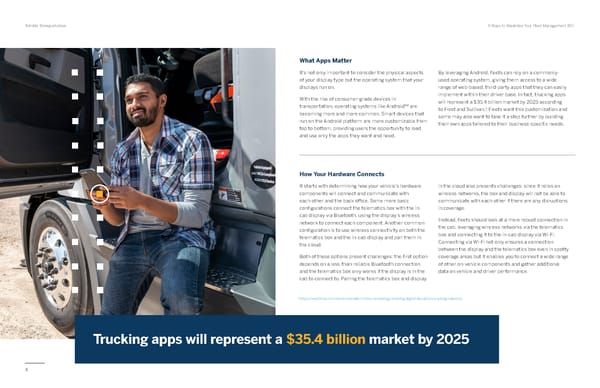4 Trimble Transportation 5 Ways to Maximize Your Fleet Management ROI It’s not only important to consider the physical aspects of your display type but the operating system that your displays run on. With the rise of consumer-grade devices in transportation, operating systems like Android™ are becoming more and more common. Smart devices that run on the Android platform are more customizable from top to bottom, providing users the opportunity to load and use only the apps they want and need. Trucking apps will represent a $35.4 billion market by 2025 How Your Hardware Connects in the cloud also presents challenges: since it relies on wireless networks, the box and display will not be able to communicate with each other if there are any disruptions in coverage. Instead, fleets should look at a more robust connection in the cab, leveraging wireless networks via the telematics box and connecting it to the in-cab display via Wi-Fi. Connecting via Wi-Fi not only ensures a connection between the display and the telematics box even in spotty coverage areas but it enables you to connect a wide range of other on-vehicle components and gather additional data on vehicle and driver performance. It starts with determining how your vehicle’s hardware components will connect and communicate with each other and the back office. Some more basic configurations connect the telematics box with the in- cab display via Bluetooth, using the display’s wireless network to connect each component. Another common configuration is to use wireless connectivity on both the telematics box and the in-cab display and pair them in the cloud. Both of these options present challenges: the first option depends on a less-than-reliable Bluetooth connection and the telematics box only works if the display is in the cab to connect to. Pairing the telematics box and display What Apps Matter By leveraging Android, fleets can rely on a commonly- used operating system, giving them access to a wide range of web-based, third-party apps that they can easily implement within their driver base. In fact, trucking apps will represent a $35.4 billion market by 2025 according to Frost and Sullivan. ¹ Fleets want this customization and some may also want to take it a step further by building their own apps tailored to their business-specific needs. 1 https://ww2.frost.com/event/calendar/mobile-technology-enabling-digital-disruption-trucking-industry/
 Maximize Your Fleet Management ROI Page 3 Page 5
Maximize Your Fleet Management ROI Page 3 Page 5